1996 GMC SIERRA clutch
[x] Cancel search: clutchPage 73 of 404
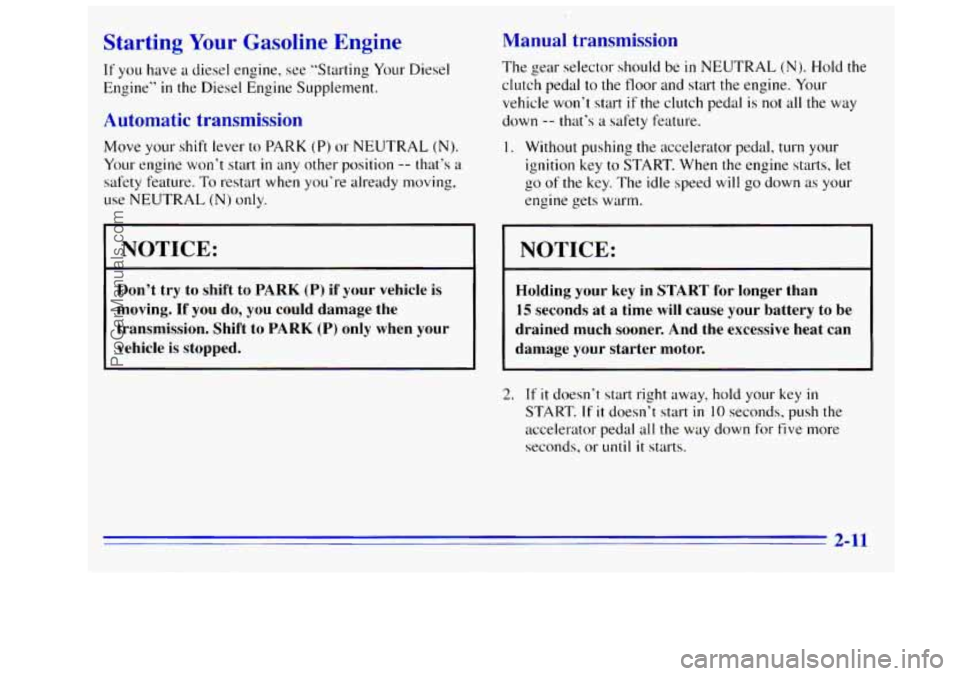
Starting Your Gasoline Engine
If you have a diesel engine, see “Starting Your Diesel
Engine”
in the Diesel Engine Supplement.
Automatic transmission
Move your shift lever to PARK (P) or NEUTRAL (N).
Your engine won’t start in any other position -- that’s a
safety feature.
To restart when you’re already moving,
use NEUTRAL
(N) only.
NOTICE:
Don’t try to shift to PARK (P) if your vehicle is
moving.
If you do, you could damage the
transmission. Shift to
PARK (P) only when your
vehicle is stopped.
Manual transmission
The gear selector should be in NEUTRAL (N). Hold the
clutch pedal
to the floor and start the engine. Your
vehicle won’t start if the clutch pedal is not all the way
down
-- that’s a safety feature.
1. Without pushing the accelerator pedal, turn your
ignition key to START. When the engine starts,
let
go of the key. The idle speed will go down as your
engine gets warm.
NOTICE:
Holding your key in START for longer than
15 seconds at a time will cause your battery to be
drained much sooner. And the excessive heat can
damage your starter motor.
2. If it doesn’t start right away, hold your key in
START. If it doesn’t start in 10 seconds, push the
accelerator pedal
all the way down for five more
seconds, or
until it starts.
2-11
ProCarManuals.com
Page 79 of 404
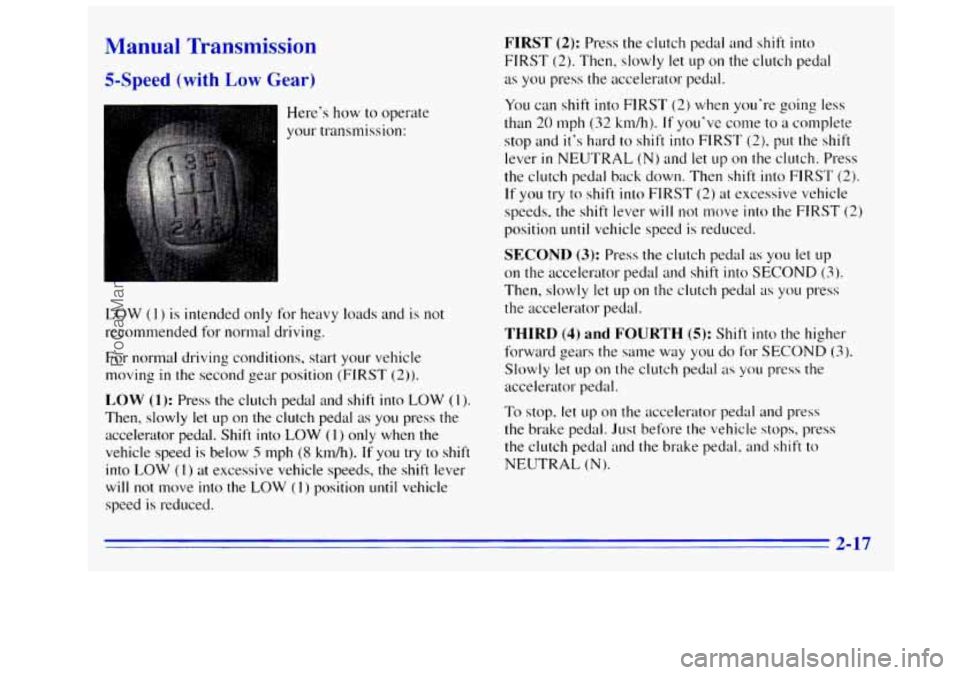
Manual Transmission
5-Speed (with Low Gear)
Here's how to operate
your transmission:
LOW
(1 ) is intended only for heavy loads and is not
recommended for normal driving.
For normal driving conditions, start
your vehicle
moving
in the second gear position (FIRST (2)).
LOW (1): Press the clutch pedal and shift into LOW (1 ).
Then, slowly let up on the clutch pedal as you press the
accelerator pedal. Shift into LOW
(1) only when the
vehicle speed is below
5 tnph (8 kmh). If you try to shift
into LOW (1) at excessive vehicle speeds, the shift lever
will not move
into the LOW (1) position until vehicle
speed is reduced.
FIRST (2): Press the clutch pedal and shift into
FIRST (2). Then. slowly let up on the clutch pedal
as you press the accelerator pedal.
You can shift into
FIRST (2) when you're going less
than
20 mph (32 kdh). If you've come to a complete
stop and it's hard to shift into
FIRST (2), put the shift
lever
in NEUTRAL (N) and let up on the clutch. Press
the clutch pedal back down. Then
shift into FIRST (2).
If you try to shift into FIRST (2) at excessive vehicle
speeds, the shift lever will not move
into the FIRST (2)
position until vehicle speed is reduced.
SECOND (3): Press the clutch pedal as you let up
on the accelerator pedal and shift into SECOND (3).
Then, slowly let up on the clutch pedal as YOLI press
the accelerator pedal.
THIRD (4) and FOURTH (5): Shift into the higher
forward gears the same way you do for
SECOND (3).
Slowly let up on the clutch pedal as you press the
accelerator pedal.
To stop. let
up on the accelerator pedal and press
the brake pedal. Just before the vehicle stops, press
the clutch pedal and the brake pedal, and shift to
NEUTRAL
(N).
2-17
ProCarManuals.com
Page 80 of 404
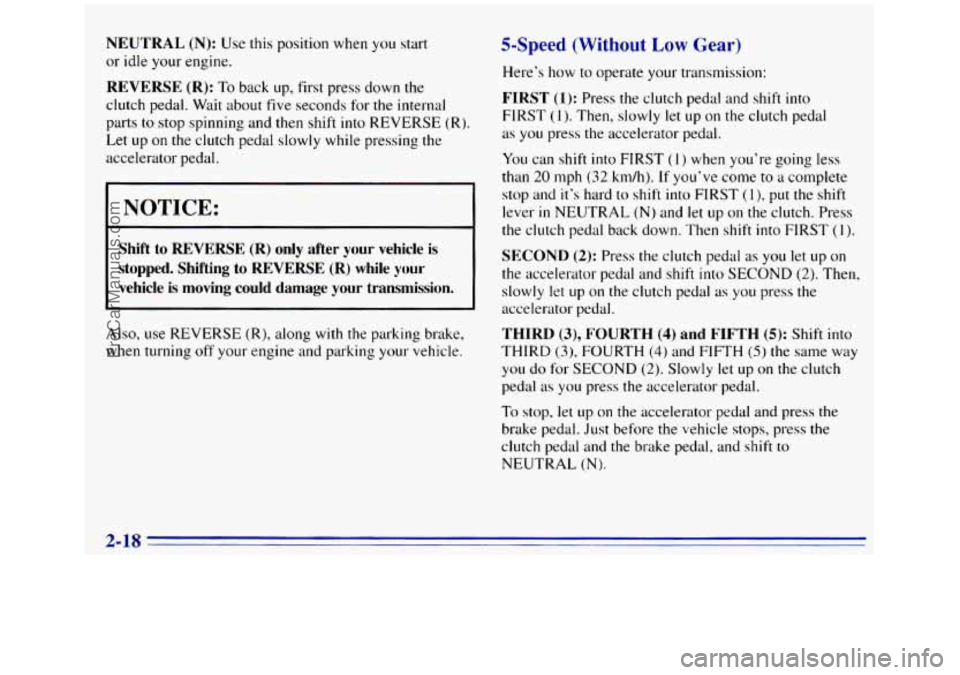
NEUTRAL (N): Use this position when YOLI start
or idle your engine.
REVERSE (R): To back up, first press down the
clutch pedal. Wait about five seconds for the internal
parts
to stop spinning and then shift into REVERSE (R).
Let up on the clutch pedal slowly while pressing the
accelerator pedal.
NOTICE:
Shift to REVERSE (R) only after your vehicle is
stopped. Shifting
to REVERSE (R) while your
vehicle is moving could damage your transmission.
Also, use REVERSE (R), along with the parking brake,
when turning off your engine and parking your vehicle.
5-Speed (Without Low Gear)
Here’s how to operate your transmission:
FIRST (1): Press the clutch pedal and shift into
FIRST
(I ). Then, slowly let up on the clutch pedal
as you press the accelerator pedal.
You can shift into FIRST
( 1 ) when you’re going less
than
20 mph (32 km/h). If you’ve come to a complete
stop and it’s hard to shift
into FIRST (l), put the shift
lever
in NEUTRAL (N) and let up on the clutch. Press
the clutch pedal back down. Then shift into FIRST
(1).
SECOND (2): Press the clutch pedal as you let up on
the accelerator pedal and shift
into SECOND (2). Then,
slowly let up on the clutch pedal as you press the
accelerator pedal.
THIRD (3), FOURTH (4) and FIFTH (5): Shift into
THIRD
(3), FOURTH (4) and FIFTH (5) the same way
you do for SECOND (2). Slowly let up on the clutch
pedal
as you press the accelerator pedal.
To stop, let up on the accelerator pedal and press the
brake pedal. Just before the vehicle stops, press the
clutch pedal and the brake pedal, and shift
to
NEUTRAL (N).
2-18
ProCarManuals.com
Page 81 of 404
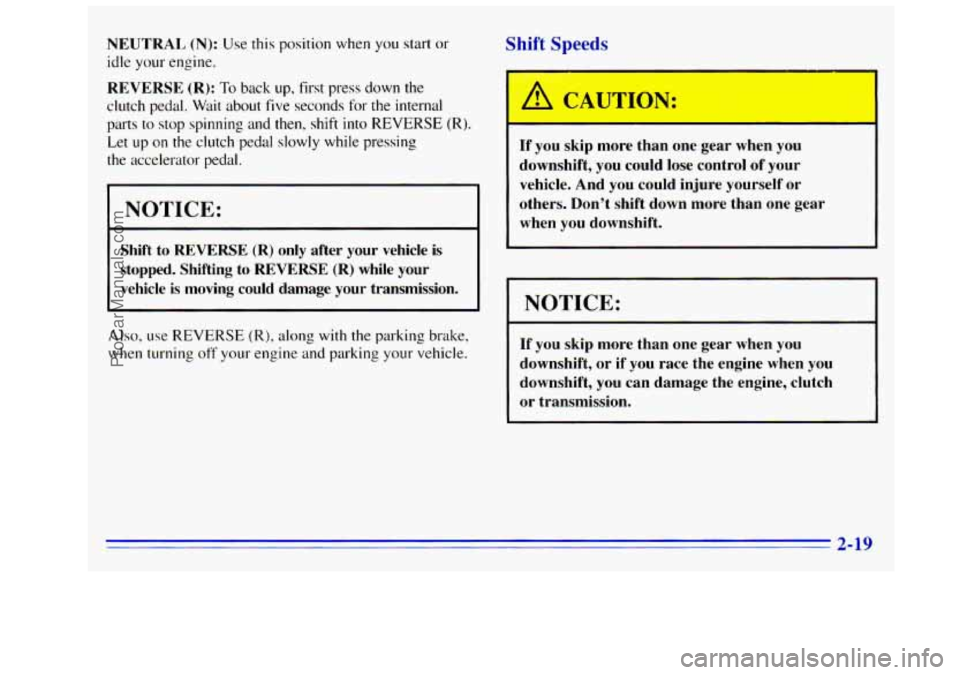
NEUTRAL (N): Use this position when you start or
idle your engine.
REVERSE (R): To back up, first press down the
clutch pedal.
Wait about five seconds for the internal
parts
to stop spinning and then, shift into REVERSE (R).
Let up on the clutch pedal slowly while pressing
the accelerator pedal.
.
NOTICE:
Shift to REVERSE (R) only after your vehicle is
stopped. Shifting to
REVERSE (R) while your
vehicle is moving could damage your transmission.
Also, use REVERSE (R), along with the parking brake,
when turning off
your engine and parking your vehicle.
Shift Speeds
A CAUTION:
If you skip more than one gear when you
downshift, you could lose control of your
vehicle. And you could injure yourself or
others. Don’t shift down more than one gear
when you downshift.
NOTICE:
If you skip more than one gear when you
downshift, or
if you race the engine when you
downshift, you can damage the engine, clutch
or transmission.
2-19
ProCarManuals.com
Page 85 of 404
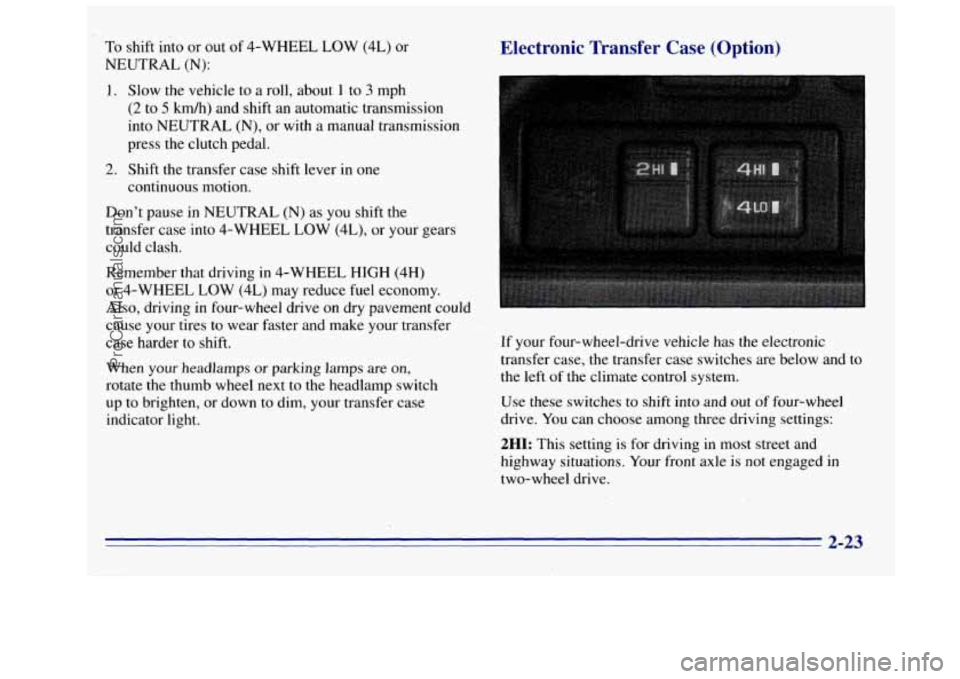
To shift into or out of 4-WHEEL LOW (4L) or
NEUTRAL
(N):
1. Slow the vehicle to a roll, about 1 to 3 mph
(2 to 5 km/h) and shift an automatic transmission
into NEUTRAL (N), or with a manual transmission
press the clutch pedal.
2. Shift the transfer case shift lever in one
continuous motion.
Don’t pause in NEUTRAL
(N) as you shift the
transfer case into 4-WHEEL LOW (4L), or your gears
could clash.
Remember that driving in 4-WHEEL HIGH (4H)
or 4-WHEEL LOW (4L) may reduce fuel economy.
Also, driving in four-wheel drive
on dry pavement could
cause your tires to wear faster and make your transfer
case harder to shift.
When
your headlamps or parking lamps are on,
rotate the thumb wheel next to the headlamp switch
up to brighten, or down
to dim, your transfer case
indicator light.
Electronic Transfer Case (Option)
If your four-wheel-drive vehicle has the electronic
transfer case, the transfer case switches are below and to
the left
of the climate control system.
Use these switches to shift into and
out of four-wheel
drive. You can choose among three driving settings:
2HI: This setting is for driving in most street and
highway situations. Your front axle is not engaged in
two-wheel drive.
2-23
ProCarManuals.com
Page 174 of 404

What should I do if my vehicle stalls, or is about
to stall, and
I can’t make it up the hill?
A: If this happens, there are some things you should
do, and these are some things you
must not do.
First, here’s what you shalrlcl do:
Push the brake pedal to stop the vehicle and
keep it from rolling backwards. Also, apply the
parking brake.
If your engine is still running, shift the transmission
to REVERSE
(R), release the parking brake, and
slowly back down the
hill in REVERSE (R).
If your engine has stopped running, you’ll need to
restart
it. With the brake pedal depressed and the
parking brake still applied, shift the transmission to
PARK (P) (or, shift to NEUTRAL (N) if your
vehicle has
a manual transmission) and restart the
engine. Then,
shift to REVERSE (R), release the
parking brake, and slowly back down the
hill as
straight as possible
in REVERSE (R).
As you are backing down the hill, put your left hand
on the steering wheel at the 12 o’clock position. This
way, you’ll be able to tell
if your wheels are straight
and maneuver as you back down.
It’s best that you
back down the
hill with your wheels straight rather
than
in the left or right direction. Turning the wheel
too far to the left or right will increase the possibility
of a rollover.
Here are sonie things you
rnusf not do if you stall, or are
about to stall, when going
up a hill.
Never attempt to prevent a stall by shifting into
NEUTRAL
(N) (or depressing the clutch, if you
have a manual transmission) to “rev-up” the engine
and regain forward momentum. This won’t work.
Your vehicle will roll backwards very quickly and
you could go out
of control.
Instead, apply the regular brake to stop the vehicle. Then
apply the parking brake. Shift to REVERSE
(R), release
the parking brake, and slowly back straight down.
Never attempt to turn around if you are about to stall
when going
up a hill. If the hill is steep enough to
stall your vehicle, it’s steep enough to cause you to
roll over if you turn around. If you can’t make it up
the
hill, you must back straight down the hill.
4-20
ProCarManuals.com
Page 176 of 404

Driving Downhill
When off-roading takes you downhill, you’ll want to
consider
a number of things:
How steep is the downhill? Will I be able to maintain
vehicle control?
What’s the surface like? Smooth? Rough? Slippery?
Hard-packed dirt? Gravel?
Logs? Boulders?
Are there hidden surface obstacles? Ruts?
What’s at the bottom of the hill‘? Is there a hidden
creek bank or even a river bottom
with large rocks?
If you decide YOU can go down a hill safely, then try to
keep your vehicle headed straight down, and use a low
gear. This way, engine drag can help your brakes and
they won’t have to do all
the work. Descend slowly,
keeping your vehicle under control at all times,
’ A CAUTION:
-
Heavy braking when going down a hill can
cause your brakes to overheat and fade. This
could cause loss
of control and a serious accident.
Apply the brakes lightly when descending
a
hill and use a low gear to keep vehicle speed
under control.
Are there some things
I should not do when
driving down a hill?
At Yes! These are important because if you ignore them
you could lose control and have a serious accident.
0 When driving downhill, avoid turns that take you
across the incline
of the hill. A hill that’s not too
steep to drive down may be too steep to drive across.
You could roll over if you don’t drive straight down.
0 Never go downhill with the transmission in
NEUTRAL (N), or with the clutch pedal depressed
in a manual shift, This is called “free-wheeling.”
Your brakes will have to
do all the work and could
overheat and fade.
ProCarManuals.com
Page 215 of 404

To engage a PTO:
1. Set the parking brake.
2. Shift the transmission into NEUTRAL (Nj.
3. Hold the clutch pedal down and engage the PTO.
NOTICE:
Using a PTO for more than four hours without
driving your vehicle can damage the transfer case
or transmission. If using a PTO for more than
four hours without driving your vehicle, drive
your vehicle for
a while to allow the transfer case
and transmission
to cool.
If you are going to drive the vehicle, shift the
transmission
into the gear you want. Then shift the
transfer case
into the range you want (if you have
four-wheel drive), apply the regular brakes and
release the parking brake.
4. Release the clutch (and the regular brakes) as you
normally would. When you release the clutch, the
PTO will start.
Using a Transfer Case Mounted Power
Take-Off
(Manual Transmission)
1. Set the parking brake,
2. Shift the transfer case into NEUTRAL (N).
3. Hold the clutch pedal down. If the vehicle will
remain
in the same place, shift the transmission into
the highest gear.
4. Engage the PTO.
If you are going to drive the vehicle, shift the
transmission into the gear
you want. Then shift the
transfer case
into the range you want, apply the
regular brakes and release the parking brake.
5. Release the clutch (and the regular brakes) as you
nor~nally would. When you release the clutch, the
PTO will start.
4-61
ProCarManuals.com